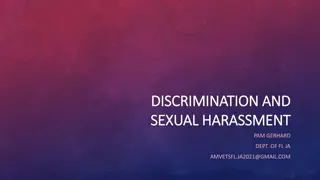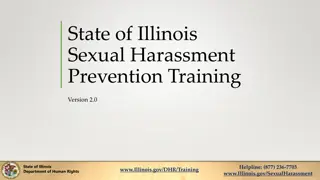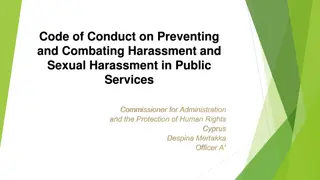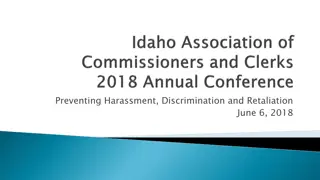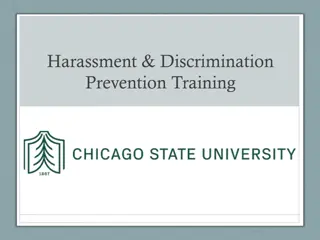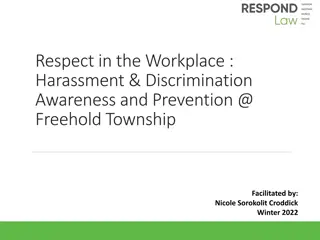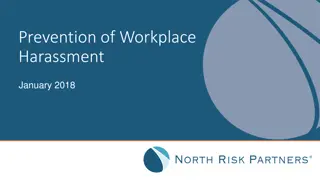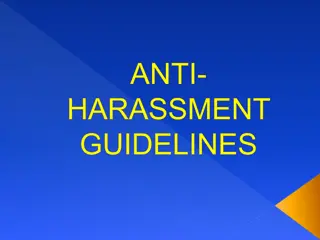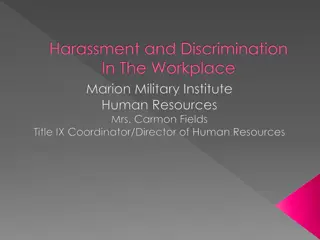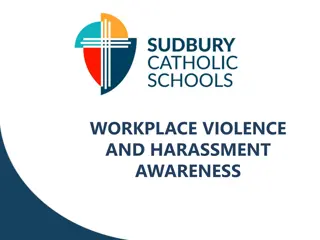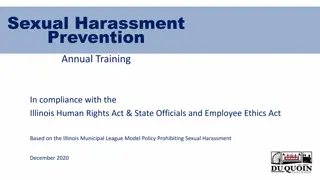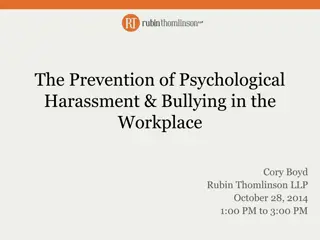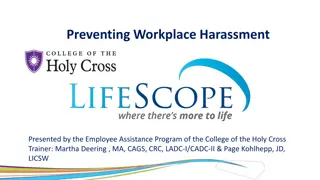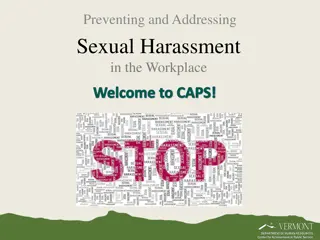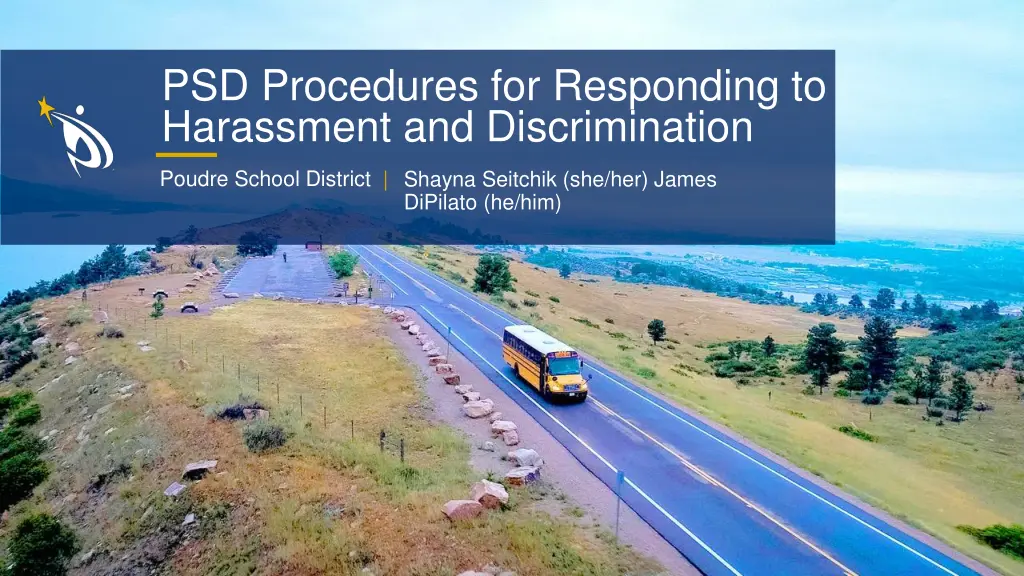
Responding to Harassment and Discrimination in Schools
Explore the procedures and legal requirements for responding to harassment and discrimination in educational settings. Learn about Title IX, state and federal laws, investigation timelines, and the scope of protected categories. Access training materials, flowcharts, and resources for creating a safe and inclusive school environment.
Download Presentation

Please find below an Image/Link to download the presentation.
The content on the website is provided AS IS for your information and personal use only. It may not be sold, licensed, or shared on other websites without obtaining consent from the author. If you encounter any issues during the download, it is possible that the publisher has removed the file from their server.
You are allowed to download the files provided on this website for personal or commercial use, subject to the condition that they are used lawfully. All files are the property of their respective owners.
The content on the website is provided AS IS for your information and personal use only. It may not be sold, licensed, or shared on other websites without obtaining consent from the author.
E N D
Presentation Transcript
PSD Procedures for Responding to Harassment and Discrimination Poudre School District | Shayna Seitchik (she/her) James DiPilato (he/him)
You may access all relevant training flowcharts, graphics, templates, and documents in the TEAMS group below: Training Resources & Materials Deputy Nondiscrimination Coordinators | General | Microsoft Teams Non-Title IX Templates (C.R.S. 22-1-143) Title IX Templates Resource Folder with Training Materials Deputy Nondiscrimination Coordinators List Know Your Rights Flyer (CRS 22-1-143).pdf
Require[s] a public school to make a good faith effort to complete an investigation and make any findings within sixty days after [a] report of harassment or discrimination. C.R.S. 22-1- 143 Prevent Harassment or Discrimination in Schools
Title IX of the Education Amendments of 1972 No person in the United States shall, on the basis of sex, be excluded from participation in, be denied the benefits of, or be subjected to discrimination under any educational program or activity receiving federal financial assistance.
Title IX Scope Sex discrimination Discrimination based on pregnancy or related conditions Discrimination based on sex stereotypes Discrimination based on sex characteristics Discrimination based on sexual orientation Discrimination based on gender identity Sex-based harassment TIX Pregnancy and Related Conditions.pdf TIX Sex-based Harassment.pdf
Incidents that occur outside of a recipients (district) educational program/activity or the U.S. that contribute to a hostile environment in the educational program/activity Nexus New 2024 Final Title IX Regulations Clarifies sex discrimination as discrimination based on sex stereotypes, sex characteristics, pregnancy or related conditions, sexual orientation, and gender identity Sexual harassment hostile environment is defined as Subjectively and Objectively offensive and is so severe OR pervasive that it limits or denies a person s ability to participate in or benefit from the recipient s education program or activity
C.R.S. 22-1-143 Flowchart Non-TIX Resolution Procedures.pdf
Title IX Flowchart TIX Resolution Procedures.pdf Sex, sexual orientation, sex stereotypes, sex characteristics, gender identity, pregnancy or related conditions
Incident Report Overview Incident Report Tool Walkthrough.pdf Staging Environment: https://sweb.psdschools.org/BiasReport/ You will not enter anything into Synergy until the investigation/resolution procedures have been completed and ONLY if the respondent is found responsible
Nondiscrimination Coordinator Roles/Responsibilities
Deputy Nondiscrimination Coordinator (includes TIX) Principal or Assistant Principal Receive reports of harassment or discrimination Document within Incident Report if not already in Incident Report Ensure supportive measures are provided and documented within Incident Report Conduct Initial Assessment Assign Investigator and Decision-Maker Ensure Investigation and Decision-Maker/Outcome Reports are uploaded into Incident Report Support students, staff, and parent/guardians as needed Coordinate with district supports as needed Ensure any applicable sanctions/ remedies are implemented
Supportive Measures Must be offered to both parties Intended to restore equal access Must not be punitive or retaliatory Consider Mental Health Special Services Provider discussing options with student and parent/guardian Accepted Supportive Measures Template.docx
Initial Assessment Definitions of Harassment/Discrimination under CRS 22-1-143 Unwanted behavior toward protected class Objectively offensive to member of the same protected class Severe or pervasive Sex-based discrimination under Title IX Sex stereotypes, sex characteristics, sexual orientation, gender identity, pregnancy or related conditions Definitions of Harassment under Title IX Quid Pro Quo Hostile Environment Sexual Assault Rape, Incest, Fondling
Deputy Nondiscrimination Coordinator Responsibilities Coordinator Responsibilities.pdf
Definition of Fondling 1. Touching 2. Private body parts (breast, buttocks, or groin) 3. Of another person 4. For the purpose of sexual gratification* 5. Without consent of the victim
Initial Assessment Form Initial Assessment Form 7.25.24.docx Includes definitions and relevant terms
Retaliation Attempts to threaten, intimidate, coerce, or discriminate against the Complainant or Respondent due to the formal grievance process Can discipline via Code of Conduct
Scenario Practice 1 A parent submits an incident report stating that her student was discriminated against because a snow day was not called by the superintendent yesterday, which led to her student being put in an unsafe condition.
Scenario Practice 2 A student submits a report through Incident Report alleging harassment based on gender identity because a teacher repeatedly uses the incorrect name, leading to classmates learning about and/or using the incorrect name. Altogether, the student alleges that they do not feel comfortable going to this class anymore, and they feel harassed by certain students outside of class.
Scenario Practice 3 A student submits a report through Incident Report alleging that another student held a knife to him in the bathroom, forced him to pull his pants down, and touched him inappropriately.
Scenario Practice 4 A group of students is reported as repeatedly using the n-word to refer to each other. Staff reports that when they addressed this with the group, all of the students stated that they choose to use this word together and always use it when addressing their friends.
Scenario Practice 5 Reports of bullying in reference to: A student s weight and This student being a virgin
Bullying and Harassment/ Discrimination When reviewing whether behavior is bullying or harassment/discrimination, consider whether the bullying is related to an individual's protected class: Disability, Race, Creed, Color, Sex, Sexual Orientation, Gender Identity, Gender Expression, Family Composition, Religion, Age, National Origin, Ancestry. If so, follow the C.R.S. 22-1-143 or Title IX process
Scenario Practice 6 TikTok trend group of students slapping each other s buttocks A group of nonbinary students report that they do not have access to facilities on a school trip because the location has segregated male and female dormitory rooms, locker rooms, and/or restrooms
Investigator(s) Investigating whether a policy violation occurred Maintaining impartiality and avoiding prejudgement Gather and review directly related evidence Interview Complainant, Respondent, witnesses Write Relevant Evidence Report and send to both parties (Only for TIX) Write Investigation Report and send to decision-maker Consider or ask about co-investigator model when staff is listed as respondent or sexual assault is alleged
Relevant Evidence Does the evidence tend to prove (inculpatory) or disprove (exculpatory) the respondent was responsible for the allegation? Not Relevant (under TIX) Treatment records, unless parties agree Legally privileged information Questions or evidence about a complainant s prior sexual predisposition or behavior unless specifically between the complainant and respondent
Interview Tips Explain role Be curious Draft questions in advance Who, what, where, when, why Clarity on timelines Repeat and rephrase statements and questions for understanding Remind parties that it is okay to say, I do not know. Provide breaks as necessary Remind parties of Retaliation Wearing a different hat Difficult questions/topics
Advisors Both parties have the right to an advisor Students should always have the right to have a parent/guardian present and may have an additional advisor Can advise complainant/respondent of rights and procedures Can ask for a pause during interviews Cannot answer questions directly on behalf of the complainant/respondent Should not continually interrupt questions from investigator or responses from complainant or respondent unless asking for a pause to consult with complainant or respondent Investigator has authority to stop and reschedule interview if necessary
Interview, Directly Related Evidence, and Investigation Reports and Documentation C.R.S. 22-1-143 (Non-Title IX) Interview Documentation (Non-Title IX).docx Investigation Report Template (Non-Title IX).docx Title IX Title IX Interview Documentation Template 7.25.24.docx Title IX Relevant Evidence Report 7.25.24.docx Title IX Investigation Report (2024) 7.25.24.docx
Decision-maker(s) Reviews investigation report, evidence, and facilitates any follow-up questions of parties For questions, start with investigator first, document, including if no response from parties Conducts an independent assessment of the evidence, including assessment of credibility of both parties and witnesses Determines whether respondent is responsible for alleged behavior and a violation of district policy by employing the preponderance of evidence standard Determines any appropriate sanctions and/or remedies Writes and send decision-maker/outcome report to all parties
Remain neutral and objective Bias Avoid pre-judgment Report any observed or perceived biases to the Nondiscrimination/Title IX or Deputy Nondiscrimination/Title IX Coordinator
Look for and note consistencies and inconsistencies Statements Written Reports Evidence Reports Credibility / Consistency
Regulations define the following as NOT relevant (TIX) Medical treatment records unless both parties agree Privileged information Questions and evidence about the complainant s sexual predisposition or prior sexual behavior unless they are offered to prove that someone other than the respondent committed the sexual harassment, or if the questions and evidence concern specific incidents of the complainant s prior sexual behaviors with the respondent and are offered to prove consent Relevancy Ordinary meaning Does the evidence tend to make a fact more or less likely to be true? Is it related to this specific situation? Is it going to help me determine whether this situation happened or not? Inculpatory- Suggests respondent is responsible Exculpatory- Suggests respondent is not responsible
Greater than 50% chance the Respondent is Responsible for the alleged conduct/policy violation More likely than not 50% plus a feather Preponderance of Evidence Standard
Consider type of evidence when engaging in fact finding Fact Finding More likely to meet preponderance of evidence standard Direct Information Documentary Information Less likely to meet preponderance of evidence standard Circumstantial Information Hearsay Information Is the information disputed? If no, this information can be considered a fact Does the other evidence corroborate the information? Consistencies Inconsistencies Evaluating Witness/Reviewing Evidence Focus on behavior, not character
Sanctions for Respondent should almost always include positive interventions (i.e. education, training, behavioral intervention, intervention plan(s), restorative practices if appropriate) Sanctions/ Remedies Disciplinary actions may include suspension, expulsion, involuntary administrative transfer, involuntary class/schedule change, restricted access to activities, etc. Remedies for Complainant should restore equal access and may look similar to supportive measures (i.e. regular meetings with support staff, hallway escorts, academic support, mutual no contact agreements)
Outcome of Investigation and Decision- Maker Reports and Documentation C.R.S. 22-1-143 (Non-Title IX) Interview Documentation (Non-Title IX).docx Outcome of Investigation Report (Non-Title IX).docx Title IX Title IX Interview Documentation Template 7.25.24.docx Title IX Decision-Maker Report (2024) 7.25.24.docx
Either party can appeal the decision/outcome within 5 business days of it being emailed Appeals Three allowable grounds: Procedural Irregularity New evidence that was not reasonably available Bias/conflict of interest from coordinator, investigator, and/or decision-maker Appeals will be handled at the district level Title IX Appeal Report 7.8.2024.docx
The Title IX process is primarily used if a student or employee chooses to file a complaint under Title IX (there are some exceptions when a district TIX coordinator would file). Employers have an obligation to investigate complaints that are related to Title VII. Student to Student In most cases, the school administration team will serve as investigator and decision maker. Note on Title VII s Intersectionality with Title IX Student & Employee Contact your HRBP. The Title IX investigation process will be used in collaboration between the school and district support, and the investigation report is sent to HR, where an HR rep will serve as the decision maker Employee to Employee Contact your HRBP. HR will use the Title IX process for sexual harassment allegations, and the Title VII workplace investigation process to look into other forms of discrimination. HR will coordinate with the school site to address any finding.
James DiPilato jdipilato@psdschools.org Shayna Seitchik sseitchik@psdschools.org Contact Information: District Title IX & Nondiscrimination Compliance Coordinators



